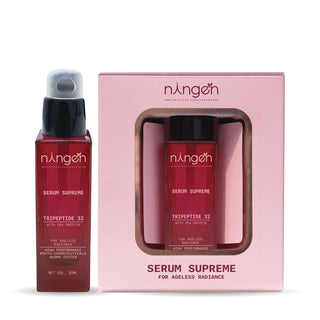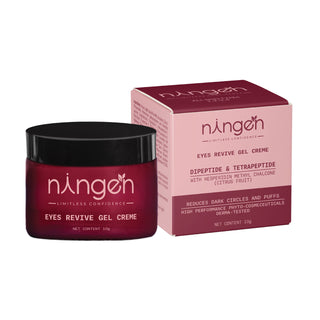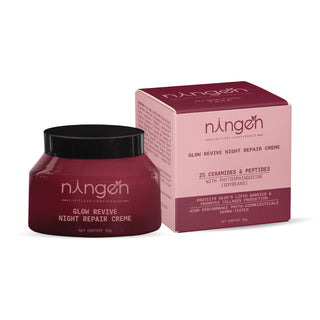TLDR:
A winter skin care routine is essential because cold air, low humidity, and indoor heating strip your skin of moisture, making it look older, duller, and more irritated. With the right routine focused on gentle cleansing, deep hydration, and barrier protection, you can restore your glow and keep your skin plump all season long.
Have you ever looked in the mirror on a December morning and wondered why your skin suddenly looks... different? More tired. Duller. Maybe even older than it was just a few months ago?
You're not imagining it. Winter doesn't just make you want to hibernate; it literally ages your skin. And if you've been using the same skincare routine year-round, that's probably why you're here, desperately Googling at 11 PM with a face that feels like parchment paper.
Here's the good news: understanding why your skin reacts poorly in winter is the first step to addressing the issue. And the even better news? The solution is simpler than you think. Let's explore why your skin appears older in winter and discover a dermatologist-recommended winter skin care routine to address it.
In this Guide;
The Science Behind Why Your Skin Looks Older in Winter
Winter Skin Problems that Can Accelerate the Aging of Skin
The Ultimate Winter Skin Care Routine That Actually Works
Lifestyle Changes for Winter Skin
The Biggest Winter Skincare Mistakes to Avoid in Winter
e Science Behind Why Your Skin Looks Older in Winter
1. Humidity Drops to Record Lows
According to the American Academy of Dermatology, when outdoor humidity falls below 30%, your skin can't hold onto moisture effectively. Winter air often drops to 10-20% humidity, basically desert-level dryness.
Your skin's outermost layer (the stratum corneum) needs about 10-30% water content to stay supple. When that drops, you get:
-
Fine lines that look more pronounced
-
Rough, flaky texture
-
Dullness and uneven tone
-
Increased sensitivity
2. Indoor Heating Is a Silent Skin Killer
Is that cozy room heater keeping you warm? It's simultaneously sucking every ounce of moisture from the air and your face. Indoor heating can reduce humidity levels to as low as 10%, creating a double-whammy effect when combined with outdoor cold.
3. Your Skin Barrier Gets Compromised
Cold weather slows down your skin's natural oil production. This weakens your moisture barrier, making it easier for water to escape (transepidermal water loss) and harder for your skin to protect itself from irritants.
4. Blood Flow Decreases
Cold temperatures constrict blood vessels, reducing circulation to your skin. Less blood flow means fewer nutrients and oxygen reaching your skin cells, which contributes to that dreaded, dull, ashen look.
The 7 Most Common Winter Skin Problems that Can Accelerate the Aging of Skin
Let's talk about the specific winter skin problems that make your skin look bad in winter
1. Extreme Dryness and Flaking
Why it happens: Winter air has very little moisture, so it pulls water out of your skin quickly. Cold winds and indoor heating also weaken the skin barrier, reducing its ability to retain hydration. This dehydration makes the skin look rough, tight, and flaky, exaggerating fine lines and giving the face an older, tired appearance
2. Eczema Flare-Ups
Why it happens: Dry winter conditions weaken the skin barrier, making it easier for irritants to trigger inflammation. This leads to redness, itching, and rough patches, which disrupt the skin's texture and accentuate creases. These flare-ups make the skin look more aged, uneven, and stressed during the colder months.

3. Chapped, Cracked Lips
Why it happens: Chapped, cracked lips appear faster in winter because lips have no oil glands to protect themselves. As cold air and low humidity pull moisture away, the skin on the lips becomes thin, dry, and more prone to lines. Over time, this dryness makes the lips look shriveled and aged, causing fine cracks and deeper creases to become more visible
4. Redness and Irritation
Why it happens: Cold winds and low humidity weaken the skin barrier and irritate capillaries, making the skin more reactive. This redness and sensitivity highlight uneven texture and contribute to an older, stressed appearance.
5. Dull, Ashy Complexion
Why it happens: When skin becomes dehydrated, dead cells build up on the surface faster. This blocks natural radiance and creates a grey, tired look, one of the main reasons skin appears older in winter.
6. Acne Breakouts
Why it happens: Dry skin forces the glands to overproduce oil to compensate. This sudden oil imbalance clogs pores and triggers breakouts, which can leave marks and uneven texture that make the skin look older.
7. Premature Aging Signs
Why it happens: Lack of moisture reduces skin elasticity and makes fine lines more visible. Dehydration shrinks the skin’s plumpness, causing wrinkles, creases, and rough patches to stand out more during winter.
The Ultimate Winter Skin Care Routine That Actually Works
Okay, enough doom and gloom. Let's fix this. Here's your step-by-step winter skincare routine that addresses every issue we just discussed.
Morning Routine
Step 1: Gentle Cleansing (Not Stripping)
What to use in Winter: Cream or oil-based cleansers
Skip the foaming cleansers that leave your skin feeling "squeaky clean"; that's actually your skin barrier crying for help. Switch to:
-
Milky cleansers with hydrating ingredients
-
Oil cleansers (yes, even for oily skin)
Step 2: Hydrating Toner or Essence
What to use in Winter: Alcohol-free toners with humectants
Apply while skin is still damp to lock in moisture.
Ingredients to look for:
-
Hyaluronic acid (holds 1000x its weight in water)
-
Glycerin
-
Beta-glucan
-
Centella asiatica
Step 3: Serum (Your Active Treatment)
What to use in Winter: Hydration-focused serums
Winter is NOT the time to go hard on exfoliating acids. Choose serums that:
-
Boost hydration (hyaluronic acid, peptides)
-
Strengthen skin barrier (niacinamide, ceramides)
-
Provide antioxidants (vitamin C, vitamin E)
Step 4: Eye Cream
What to use in Winter: Rich, peptide-based eye creams
The skin around your eyes is the thinnest and shows winter dry skin first. Pat (don't rub) a nourishing eye cream around the orbital bone.
Step 5: Moisturizer (The Star of Winter Skin Care)
What to use in Winter: Richer, occlusive winter moisturizers
This is where you need to upgrade from your summer lotion. According to dermatologists at the Cleveland Clinic, winter moisturizers should contain:
Humectants (draw water to skin):
-
Hyaluronic acid
-
Glycerin
-
Honey
Emollients (smooth and soften):
-
Ceramides
-
Fatty acids
-
Cholesterol
Occlusives (seal in moisture):
-
Petrolatum
-
Dimethicone
-
Shea butter
-
Squalane
Step 6: SPF (Yes, Even in Winter)
What to use: Mineral or moisturizing chemical sunscreen (SPF 30+)
UV rays bounce off snow and ice, increasing exposure by up to 80%. Plus, winter sun can still cause damage. Choose a sunscreen that doubles as extra moisture.
Evening Routine
Step 1: Double Cleanse
Start with an oil-based cleanser to remove sunscreen and makeup, then follow with your gentle cream cleanser.
Step 2: Hydrating Toner
Same as morning.
Step 3: Treatment Serum
This is when you can use targeted treatments:
-
Retinol (use carefully—2-3x/week max in winter)
-
Peptides for anti-aging
-
Niacinamide for barrier repair
Important: If using retinol, buffer it with moisturizer to prevent irritation.
Step 4: Eye Cream
Same as morning.
Step 5: Night Cream or Sleeping Mask
What to use in winter: Extra-rich night creams or overnight masks
Go heavier at night. Your skin repairs itself while you sleep, and a thick occlusive layer prevents moisture loss.

Step 6: Face Oil or Balm (Optional)
What to use: Face oils or healing balms
For extremely dry skin, seal everything in with a few drops of:
-
Marula oil
-
Rosehip oil
-
Jojoba oil
Beyond Your Routine: 8 Lifestyle Changes for Winter Skin
Your winter skin care routine is only half the battle. Here's what else you need to do:
1. Invest in a Humidifier
Run a humidifier in your bedroom (aim for 40-50% humidity). The Mayo Clinic confirms this single change can dramatically improve skin hydration overnight.
2. Lower Your Shower Temperature
Hot showers feel amazing but strip your skin's natural oils. Stick to lukewarm water and limit showers to 5-10 minutes.
3. Protect Your Face Outdoors
Wear a scarf or face mask to shield your skin from harsh winds. This prevents direct exposure that causes redness and irritation.
4. Stay Hydrated
Just because you're not sweating doesn't mean you don't need water. Aim for 8 glasses daily to hydrate from within.
5. Eat Omega-3 Rich Foods
Salmon, walnuts, flaxseeds, and chia seeds support your skin's lipid barrier from the inside out.
6. Don't Skip Exfoliation (Just Be Gentle)
Exfoliate 1-2x per week with a gentle chemical exfoliant (lactic acid or PHA) to remove dead skin buildup without irritation.
7. Watch Your Hands
Cold-weather skin issues affect hands dramatically. Wear gloves outside and apply hand cream after every wash.
8. Consider a Skin Supplement
Omega-3s, ceramides, and hyaluronic acid supplements can support skin hydration from within (consult your doctor first).
Special Concerns: Tailoring Your Winter Skincare Routine for Glowing Skin
For Oily/Acne-Prone Skin
Don't skip moisturizer! Use lightweight gel-creams with hyaluronic acid and niacinamide. Your skin may be producing excess oil because it's dehydrated.
For Mature Skin
Layer products for maximum hydration: essence + serum + moisturizer + facial oil. Focus on peptides and ceramides to support collagen and barrier function.
For Sensitive/Eczema-Prone Skin
Stick to fragrance-free, minimal-ingredient products. Look for colloidal oatmeal, ceramides, and centella asiatica. Consider prescription treatments if OTC products aren't enough.
For Combination Skin
Multi-mask: Use richer cream on dry areas (cheeks, around nose) and lighter gel moisturizer on oily zones (T-zone).
The Biggest Winter Skincare Mistakes to Avoid in Winter
Even with good intentions, these common mistakes can sabotage your glow:
❌ Using the same routine year-round ✅ Switch to richer products as temperatures drop
❌ Over-exfoliating ✅ Reduce frequency to 1-2x per week with gentle acids
❌ Skipping sunscreen ✅ UV damage happens in winter too, especially with snow reflection
❌ Taking hot showers ✅ Keep water lukewarm and pat dry (don't rub)
❌ Ignoring your body skin ✅ Apply body lotion immediately after bathing on damp skin
❌ Waiting too long to moisturize ✅ Apply within 3 minutes of washing to lock in hydration
❌ Using harsh, foaming cleansers ✅ Switch to cream or oil-based cleansers
When to See a Dermatologist
If you're dealing with:
-
Severe, painful cracking or bleeding
-
Eczema flares that won't respond to OTC treatments
-
Extreme redness or inflammation
-
Skin infections (crusting, oozing, or warmth)
-
Sudden changes in moles or skin texture
...it's time to see a board-certified dermatologist. The American Academy of Dermatology offers a "Find a Dermatologist" tool on its website.

The Final Insights: Your Winter Glow-Up Starts Now
Here's the truth: winter dry skin isn't inevitable. It's just your skin telling you it needs a different approach.
By understanding the science behind why skin looks dull in winter and implementing this targeted winter skin care routine, you're not just treating symptoms—you're actually preventing the accelerated aging that happens when your skin stays dehydrated for months.
Start with three key changes:
-
Switch to a cream cleanser
-
Upgrade to a richer moisturizer
-
Add a humidifier to your bedroom
These alone will transform your skin within a week. Then gradually incorporate the other steps, and watch your winter glow come back.
Your skin doesn't have to look older in winter. It just needs you to listen to what it's asking for.
Have you tried any of these winter skincare tips? What's been your biggest challenge with winter skin? Drop your questions and experiences in the comments. I'd love to hear what's working (or not working) for you!
Frequently Asked Questions
Q1. Why does my skin get so dry in winter, even though I use moisturizer?
Low humidity and indoor heating cause moisture to evaporate faster than your regular moisturizer can replace it. You need to switch to heavier, occlusive moisturizers with ingredients like ceramides, shea butter, and petrolatum that create a protective barrier. Also, apply moisturizer to damp skin within 3 minutes of cleansing to trap maximum hydration.
Q2. Can winter weather really make my skin age faster?
Yes. Chronic dehydration from winter weather causes fine lines to appear deeper, reduces skin elasticity, and slows cell turnover. Studies show that dry skin is more susceptible to environmental damage and shows visible signs of aging faster than well-hydrated skin. However, this is temporary and reversible with proper winter skin care.
Q3. Should I stop using retinol in winter?
You don't have to stop completely, but you should reduce frequency (2-3x per week) and buffer it with moisturizer. Retinol can be more irritating on already compromised winter skin. If you experience excessive dryness or irritation, take a break and focus on barrier repair with ceramides and niacinamide instead.
Q4. What's the best type of moisturizer for winter dry skin?
Look for moisturizers with all three types of hydrating ingredients: humectants (hyaluronic acid, glycerin), emollients (ceramides, fatty acids), and occlusives (petrolatum, dimethicone, shea butter). Cream or balm formulations work better than lotions for winter. Ingredients like squalane, niacinamide, and cholesterol are especially effective for barrier repair.
Q5. How can I tell if my skin barrier is damaged?
Signs of a compromised skin barrier include: persistent tightness after cleansing, increased sensitivity to products that didn't bother you before, redness and irritation, excessive dryness despite moisturizing, burning or stinging sensations, and frequent breakouts. Focus on gentle, fragrance-free products with ceramides and avoid exfoliating until your barrier heals.
Q6. Is it normal for my skin to feel tight all day in winter?
While common, this isn't "normal" or healthy, t's a sign of severe dehydration. Your skin shouldn't feel tight or uncomfortable. This indicates your moisture barrier is compromised and you need to: use a gentler cleanser, apply a hydrating toner or essence, upgrade to a richer moisturizer, use a humidifier, and possibly add a facial oil or occlusive balm at night.
Q7. Can drinking more water fix my winter dry skin?
Drinking water helps overall hydration but won't directly fix topical dryness caused by environmental factors. You need both: internal hydration (water, omega-3s) AND external hydration (proper moisturizers, humidifiers). Think of it like a plant, watering the roots helps, but if the air is too dry, the leaves will still shrivel.
Q8. Why do I break out more in winter if my skin is dry?
This is called "moisture barrier dysfunction." When your skin is dehydrated, it overcompensates by producing more oil, which can clog pores. Additionally, using harsh products to combat dryness can irritate skin and trigger breakouts. Solution: Use lightweight but hydrating products with niacinamide and hyaluronic acid, and don't skip moisturizer even if you're oily.
Q9. How long does it take to see results from a winter skincare routine?
You should notice improved hydration and reduced tightness within 3-7 days of switching to proper winter products and using a humidifier. However, healing a severely compromised moisture barrier and seeing significant improvement in texture, glow, and fine lines typically takes 2-4 weeks of consistent care.
Q10. Should I change my skincare routine back when spring arrives?
Yes, gradually transition as weather warms and humidity increases. You can switch to lighter moisturizers, increase exfoliation frequency, and potentially introduce stronger active ingredients. Pay attention to your skin's signals, if it feels heavy or congested, it's time to lighten up. Think of skincare as seasonal wardrobes: you wouldn't wear a winter coat in May!
About the Sources: This article references guidelines from the American Academy of Dermatology, National Eczema Association, Cleveland Clinic, and Mayo Clinic, all leading authorities in dermatological care and skin health research.











